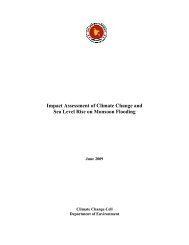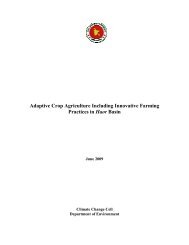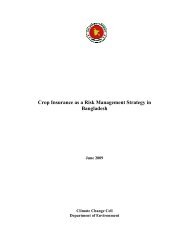CLIMATE CHANGE AND BANGLADESH
CLIMATE CHANGE AND BANGLADESH
CLIMATE CHANGE AND BANGLADESH
You also want an ePaper? Increase the reach of your titles
YUMPU automatically turns print PDFs into web optimized ePapers that Google loves.
Tomorrow’s climate and risks<br />
The IPCC Working Group II has reported in their fourth assessment this year that the production of rice and wheat might drop in Bangladesh by 8 percent and<br />
32 percent respectively, by the year 2050. Bangladesh is especially susceptible to increasing salinity of their groundwater as well as surface water resources,<br />
especially along the coast, due to increases in sea level as a direct impact of global warming. With a 1m rise in sea level, the Sunderban mangrove forest is<br />
likely to be lost; Bangladesh would be worst affected by the sea level rise in terms of loss of land. Approximately 1000 square kilometers of cultivated land and<br />
sea product culturing area is likely to become salt marsh. Projected sea-level rise Projected sea-level rise could flood the residence of millions of people living in<br />
the low lying areas such as in Bangladesh. Even under the most conservative scenario, sea level will be about 40 cm higher than today by the end of 21st<br />
century and this is projected to increase the annual number of people flooded in coastal populations from 13 million to 94 million worldwide. Almost 60 percent<br />
of this increase will occur along the coast in South Asia. The coastal lowlands below the elevation of 1,000-year storm surge are widely distributed in<br />
Bangladesh where millions of people live. Global burden (mortality and morbidity) of climate-change attributable diarrhea and malnutrition are already the<br />
largest in Bangladesh. The relative risks for these conditions for 2030 are expected to be also the largest. Bangladesh’s population is expected to increase by<br />
130 million more people over the next 50 years. Climatic changes in Bangladesh would likely exacerbate present environmental conditions that give rise to land<br />
degradation, shortfalls in food production, rural poverty and urban unrest. About 15,000 Himalayan glaciers form a unique reservoir which supports perennial<br />
rivers such as the Indus, Ganges and Brahmaputra which, in turn, are the lifeline of millions of people in Bangladesh. (IPCC, 2007)<br />
A very high rate of sedimentation is predicted due to the increased flow in the rivers from increased rainfall in the upper catchment and from rapid melt of<br />
glaciers during summer in the next few decades. This will cause further erosion of the riverbanks, islands and coastal Bangladesh.<br />
Climate change has the potential to undermine poverty reduction efforts and could compromise the Millennium Development Goals (MDGs), such as the<br />
eradication of extreme poverty and hunger by 2015. The OECD and the World Bank estimate that 40% of overseas development assistance to Bangladesh may<br />
be climate sensitive or at risk. Additionally, funding for humanitarian response to disasters (majority of which are climate related), which now cost donors<br />
millions of dollars per year, may result in the reallocation of funding from on-going development activities. This can set back the development process for<br />
decades.<br />
Climate risks for Bangladesh<br />
Environmental Impacts<br />
• Changes in rainfall patterns<br />
• Increased frequency and severity of:<br />
Floods<br />
Droughts<br />
Storms<br />
Heat waves<br />
• Changes in growing seasons and regions<br />
• Changes in water quality and quantity<br />
• Sea level rise<br />
• Glacial melt<br />
Socio-economic Resources & Sectors<br />
affected<br />
• Water resources<br />
• Agriculture and forestry<br />
• Food security<br />
• Human health<br />
• Infrastructure (e.g. transport)<br />
• Settlements: displacement of<br />
inhabitants and loss of livelihood<br />
• Coastal management<br />
• Industry and energy<br />
• Disaster response & recovery plans<br />
10





